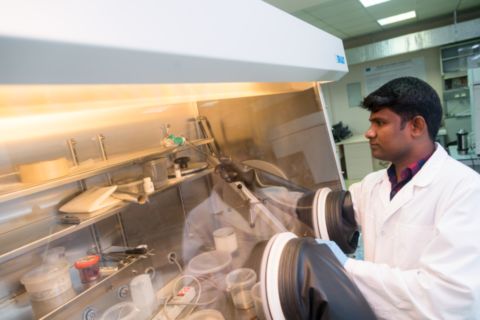Russian and Indian scientists from South Ural State University are conducting research in understudied areas of chemistry in order to create new high-tech materials and study their properties. These substances can be widely used in many areas, for example, in the production of solar cells, new generation lasers or medical equipment. Scientists have recently managed to synthesize an unusual combination of antimony with iodine. The research results have been published in the highly rated scientific journal called New Journal of Chemistry (Q2).
Scientists have synthesized new material from antimony
Researcher fellows at the Laboratory of Crystal Chemical Design and the SUSU Institute of Natural Sciences and Mathematics, Nikolaev Institute of Inorganic Chemistry of the Siberian Branch of the Russian Academy of Sciences, Novosibirsk, and Saint Petersburg State University obtained the first joint results: they have synthesized and studied a new antimony compound with an unusual structure, which may turn out to be a promising catalyst.
Organoelement derivatives of antimony are a wide class of compounds, interesting for some types of their biological activity. At SUSU, this line of research is developing thanks to the work guided by Doctor of Sciences (Chemistry), Professor Vladimir Sharutin.
"Studying the interaction of substances of the tris (aryl) class of antimony with iodine, it was found that the reactions proceed differently depending on the nature of the organic substituent. One of the isolated products has an unusual structure: it contains previously unknown [R3SbI]+ cations. Using quantum chemical calculations, it was shown that they can form strong non-covalent interactions – the so-called halogen and pnictogenic bonds. This property can cause the catalytic activity of compounds of this class," explained Doctor of Sciences (Chemistry) Sergei Adonin.
It is important to note that the study of halogen bonds is one of the most urgent areas in chemistry today, and Russia is in seventh place in the world in the number of scientific publications on this topic. In particular, SUSU scientists published 16 scientific articles in journals indexed in the Scopus Scientometric Database in 2020. Among these top scientific journals are Inorganica Chimica Acta, Chemical Communications, and Journal of Molecular Structure.
Halogen bonds can participate in crystals with nonlinear optical properties (for example, in some types of lasers). Halogen bonds can be used in the production of solar cells, and this, in turn, is a big step towards "green" energy engineering, which is a very relevant area for scientific research. They are also used in the production of new generation sensors, that is, for telephones and high-tech devices, including medical ones. Thus, all the research carried out by the laboratory helps to make high technologies a reality.
.jpg)
Cooperation with the Russian Academy of Sciences
This year, a Laboratory of Crystal Chemical Design of Functional Materials was established at the SUSU Nanotechnology Research and Education Centre. As part of the laboratory, Academician of the Russian Academy of Sciences, Doctor of Sciences (Chemistry), Professor of Saint Petersburg State University Vadim Kukushkin participates in joint research. The Department of Materials Science and Physicochemistry of Materials under the leadership of Doctor of Sciences (Chemistry), Professor Denis Vinnik is also involved in the work. The international team of scientists includes a highly qualified specialist from India, Doctor of Sciences (Chemistry) Rajakumar Kanthapazham. The head of the laboratory is Sergey Adonin.
"The laboratory is engaged in crystal chemical design of new materials based on non-bonded interactions, such as halogen bonds and chalcogen bonds. The creation of new materials is the task that scientists are trying to solve, and they succeed. For example, at the laboratory it is possible to create luminescent sensors, magnetic materials, and solar panels elements. The development of in-demand materials on a practical level is considered to be an extremely important task for the laboratory," says Candidate of Sciences (Chemistry) Dmitrii Zherebtsov.
.jpg)
The fundamental research on organic compounds containing halogen bonds is carried out at the laboratory. They arise between oxygen atoms and atoms of halogen elements – chlorine, bromine and iodine. Halogen bonds involving iodine atoms belong to a promising but little-studied field of chemistry.
Research in new materials is among the priorities of the World-Class Ural Region Research and Education Centre for Advanced Industrial Technology, New Materials and Power Engineering, which is currently being created by the joint efforts of SUSU, Ural Federal University, Kurgan State University and other regional higher educational institutions, the Ural branch of the Russian Academy of Sciences, industrial enterprises and governments of the Chelyabinsk, Sverdlovsk and Kurgan regions.
SUSU is a participant of Project 5-100, which aims at enhancing competitiveness of Russian universities among global leading research and educational centres.




